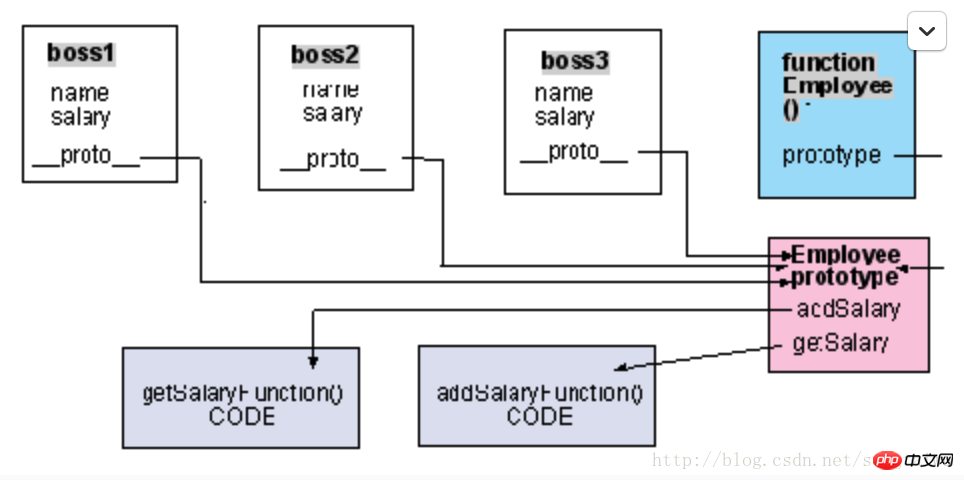js的Prototype屬性用法詳解
每一個建構函式都有一個屬性叫做原型(prototype,下面都不再翻譯,使用其原文)。這個屬性非常有用:為一個特定類別聲明通用的變數或函數。
prototype的定義你不需要明確地宣告一個prototype屬性,因為在每個建構函式中都有它的存在。你可以看看下面的範例:
Example PT1
CODE:
function Test()
{
}
alert(Test.prototype); // 输出 “Object"為prototype新增屬性
就如你在上面所看到的,prototype是一個對象,因此,你能夠給它添加屬性。你加入給prototype的屬性將會成為使用這個建構函式建立的物件的通用屬性。
例如,我下面有一個資料類型Fish,我想讓所有的魚都有這些屬性:livesIn="water"和price=20;為了實現這個,我可以給構造函數Fish的prototype添加那些屬性。
Example PT2
CODE:
function Fish(name, color)
{
this.name=name;
this.color=color;
}
Fish.prototype.livesIn="water";
Fish.prototype.price=20;接下來讓我們作幾條魚:
CODE:
var fish1=new Fish("mackarel", "gray");
var fish2=new Fish("goldfish", "orange");
var fish3=new Fish("salmon", “white");再來看看魚有哪些屬性:
CODE:
for (int i=1; i<=3; i++)
{
var fish=eval_r("fish"+i); // 我只是取得指向这条鱼的指针
alert(fish.name+","+fish.color+","+fish.livesIn+","+fish.price);
}#輸出應該是:
CODE:
"mackarel, gray, water, 20" "goldfish, orange, water, 20" "salmon, white water, 20”
你看到所有的魚都有屬性livesIn和price,我們甚至都沒有為每一條不同的魚特別聲明這些屬性。這時因為當一個物件被創建時,這個建構子 會把它的屬性prototype賦給新物件的內部屬性__proto__。這個__proto__被這個物件用來找出它的屬性。
你也可以透過prototype來為所有物件新增共用的函數。這有一個好處:你不需要每次在建構一個物件的時候創建並初始化這個函數。為了解釋這一點,讓我們重新來看Example DT9並使用prototype來重寫它:
用prototype為物件添加函數
Example PT3
#CODE :
function Employee(name, salary)
{
this.name=name;
this.salary=salary;
}
Employee.prototype.getSalary=function getSalaryFunction()
{
return this.salary;
}
Employee.prototype.addSalary=function addSalaryFunction(addition)
{
this.salary=this.salary+addition;
}我們可以像通常那樣建立物件:
CODE:
var boss1=new Employee("Joan", 200000);
var boss2=new Employee("Kim", 100000);
var boss3=new Employee("Sam", 150000);並驗證它:

alert(boss1.getSalary()); // 输出 200000 alert(boss2.getSalary()); // 输出 100000 alert(boss3.getSalary()); // 输出 150000
以上是js的Prototype屬性用法詳解的詳細內容。更多資訊請關注PHP中文網其他相關文章!

熱AI工具

Undresser.AI Undress
人工智慧驅動的應用程序,用於創建逼真的裸體照片

AI Clothes Remover
用於從照片中去除衣服的線上人工智慧工具。

Undress AI Tool
免費脫衣圖片

Clothoff.io
AI脫衣器

AI Hentai Generator
免費產生 AI 無盡。

熱門文章

熱工具

記事本++7.3.1
好用且免費的程式碼編輯器

SublimeText3漢化版
中文版,非常好用

禪工作室 13.0.1
強大的PHP整合開發環境

Dreamweaver CS6
視覺化網頁開發工具

SublimeText3 Mac版
神級程式碼編輯軟體(SublimeText3)

熱門話題
 Win11管理員權限取得詳解
Mar 08, 2024 pm 03:06 PM
Win11管理員權限取得詳解
Mar 08, 2024 pm 03:06 PM
Windows作業系統是全球最受歡迎的作業系統之一,其新版本Win11備受矚目。在Win11系統中,管理員權限的取得是一個重要的操作,管理員權限可以讓使用者對系統進行更多的操作和設定。本文將詳細介紹在Win11系統中如何取得管理員權限,以及如何有效地管理權限。在Win11系統中,管理員權限分為本機管理員和網域管理員兩種。本機管理員是指具有對本機電腦的完全管理權限
 Oracle SQL中的除法運算詳解
Mar 10, 2024 am 09:51 AM
Oracle SQL中的除法運算詳解
Mar 10, 2024 am 09:51 AM
OracleSQL中的除法運算詳解在OracleSQL中,除法運算是一種常見且重要的數學運算運算,用來計算兩個數相除的結果。除法在資料庫查詢中經常用到,因此了解OracleSQL中的除法運算及其用法是資料庫開發人員必備的技能之一。本文將詳細討論OracleSQL中除法運算的相關知識,並提供具體的程式碼範例供讀者參考。一、OracleSQL中的除法運算
 PHP模運算子的作用及用法詳解
Mar 19, 2024 pm 04:33 PM
PHP模運算子的作用及用法詳解
Mar 19, 2024 pm 04:33 PM
PHP中的模運算子(%)是用來取得兩個數值相除的餘數的。在本文中,我們將詳細討論模運算子的作用及用法,並提供具體的程式碼範例來幫助讀者更好地理解。 1.模運算子的作用在數學中,當我們將一個整數除以另一個整數時,就會得到一個商和一個餘數。例如,當我們將10除以3時,商數為3,餘數為1。模運算子就是用來取得這個餘數的。 2.模運算子的用法在PHP中,使用%符號來表示模
 linux系統呼叫system()函數詳解
Feb 22, 2024 pm 08:21 PM
linux系統呼叫system()函數詳解
Feb 22, 2024 pm 08:21 PM
Linux系統呼叫system()函數詳解系統呼叫是Linux作業系統中非常重要的一部分,它提供了一種與系統核心互動的方式。其中,system()函數是常用的系統呼叫函數之一。本文將詳細介紹system()函數的使用方法,並提供對應的程式碼範例。系統呼叫的基本概念系統呼叫是使用者程式與作業系統核心互動的一種方式。使用者程式透過呼叫系統呼叫函數來請求作業系統
 Linux的curl指令詳解
Feb 21, 2024 pm 10:33 PM
Linux的curl指令詳解
Feb 21, 2024 pm 10:33 PM
Linux的curl命令詳解摘要:curl是一種強大的命令列工具,用於與伺服器進行資料通訊。本文將介紹curl指令的基本用法,並提供實際的程式碼範例,幫助讀者更好地理解和應用該指令。一、curl是什麼? curl是命令列工具,用於發送和接收各種網路請求。它支援多種協議,如HTTP、FTP、TELNET等,並提供了豐富的功能,如檔案上傳、檔案下載、資料傳輸、代
 簡易JavaScript教學:取得HTTP狀態碼的方法
Jan 05, 2024 pm 06:08 PM
簡易JavaScript教學:取得HTTP狀態碼的方法
Jan 05, 2024 pm 06:08 PM
JavaScript教學:如何取得HTTP狀態碼,需要具體程式碼範例前言:在Web開發中,經常會涉及到與伺服器進行資料互動的場景。在與伺服器進行通訊時,我們經常需要取得傳回的HTTP狀態碼來判斷操作是否成功,並根據不同的狀態碼來進行對應的處理。本篇文章將教你如何使用JavaScript來取得HTTP狀態碼,並提供一些實用的程式碼範例。使用XMLHttpRequest
 詳細解析C語言學習路線
Feb 18, 2024 am 10:38 AM
詳細解析C語言學習路線
Feb 18, 2024 am 10:38 AM
C語言作為一門廣泛應用在軟體開發領域的程式語言,是許多程式設計師初學者的首選。學習C語言不僅可以幫助我們建立程式設計的基礎知識,還可以提升我們解決問題和思考的能力。本文將詳細介紹一條C語言學習的路線圖,幫助初學者更好地規劃自己的學習進度。 1.學習基本文法在開始學習C語言之前,我們首先需要先了解C語言的基本文法規則。這包括變數和資料類型、運算子、控制語句(如if語句、
 深入了解Promise.resolve()
Feb 18, 2024 pm 07:13 PM
深入了解Promise.resolve()
Feb 18, 2024 pm 07:13 PM
Promise.resolve()詳解,需要具體程式碼範例Promise是JavaScript中一種用來處理非同步操作的機制。在實際開發中,常常需要處理一些需要依序執行的非同步任務,而Promise.resolve()方法就是用來傳回一個已經Fulfilled狀態的Promise物件。 Promise.resolve()是Promise類別的靜態方法,它接受一個






